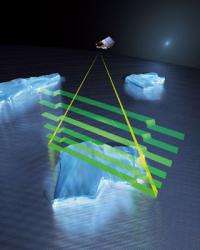CryoSat to observe Earth's ice cover (w/ Video)

(PhysOrg.com) -- The European Space Agency is about to launch the most sophisticated satellite ever to investigate the Earth's ice fields and map ice thickness over water and land: lift-off scheduled for 25 February.
Lift-off is scheduled to take place at 14:57 CET (13:57 UTC) on Thursday 25 February 2010. The launcher is operated by the international space company Kosmotras.
CryoSat will be the third of ESA’s Earth Explorer satellites in orbit, following on from GOCE (launched in March 2009) and SMOS (launched in November 2009). It was originally due to be the first in the Earth Explorer series, but the first satellite was lost as a result of a launcher failure in October 2005.
The 700 kg CryoSat spacecraft - whose name comes from the Greek kruos meaning icy cold - carries the first all-weather microwave radar altimeter. The instrument has been optimised for determining changes in the thickness of both floating sea ice, which can be up to several metres, and polar land ice sheets, which in Antarctica can be up to five kilometres. The mission will deliver data on the rate of change of the ice thickness accurate to within one centimetre.
Recent record-lows in the extent of summer Arctic sea-ice cover demonstrate that significant changes are occurring in the polar regions. Ice cover has been mapped from space for many years by satellites such as Envisat. But to understand more about how climate change is affecting these sensitive regions, there is also an urgent need to determine how ice thickness is changing. Data from CryoSat will lead to a better understanding of the dynamics of ice mass, provide the scientific community with valuable information on this variable and contribute to climate change studies.
Provided by European Space Agency


















